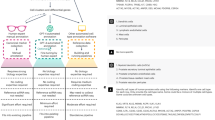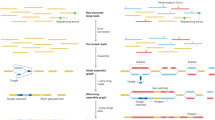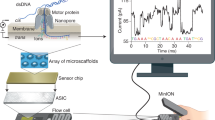Abstract
Three benchtop high-throughput sequencing instruments are now available. The 454 GS Junior (Roche), MiSeq (Illumina) and Ion Torrent PGM (Life Technologies) are laser-printer sized and offer modest set-up and running costs. Each instrument can generate data required for a draft bacterial genome sequence in days, making them attractive for identifying and characterizing pathogens in the clinical setting. We compared the performance of these instruments by sequencing an isolate of Escherichia coli O104:H4, which caused an outbreak of food poisoning in Germany in 2011. The MiSeq had the highest throughput per run (1.6 Gb/run, 60 Mb/h) and lowest error rates. The 454 GS Junior generated the longest reads (up to 600 bases) and most contiguous assemblies but had the lowest throughput (70 Mb/run, 9 Mb/h). Run in 100-bp mode, the Ion Torrent PGM had the highest throughput (80–100 Mb/h). Unlike the MiSeq, the Ion Torrent PGM and 454 GS Junior both produced homopolymer-associated indel errors (1.5 and 0.38 errors per 100 bases, respectively).
This is a preview of subscription content, access via your institution
Access options
Subscribe to this journal
Receive 12 print issues and online access
$209.00 per year
only $17.42 per issue
Buy this article
- Purchase on Springer Link
- Instant access to full article PDF
Prices may be subject to local taxes which are calculated during checkout



Similar content being viewed by others
Change history
23 April 2012
On page 2, “error rates” has been corrected to “quality scores” in the sentence “Alignment quality scores measured in this way generally had good agreement with predicted scores, with the Ion Torrent PGM generally underestimating error rates and the other instruments slightly overestimating them (Supplementary Fig. 2).” The corrected sentence reads “Alignment quality scores measured in this way generally had good agreement with predicted scores, with the Ion Torrent PGM generally underestimating quality scores and the other instruments slightly overestimating them (Supplementary Fig. 2).”
07 June 2012
In the version of this article initially published online, in the Online Methods “Ion Torrent Sequencing” section, the sentence beginning with “Ten milligrams of this DNA was fragmented with a Bioruptor instrument….” should have read “Ten micrograms….” and in the “454 GS Junior sequencing” section, “(500 total)” should have read “(500 ng total).” The errors have been corrected in the PDF and HTML versions of this article.
References
Pallen, M.J., Nelson, K. & Preston, G.M. Bacterial Pathogenomics (ASM Press, 2007).
Metzker, M. Sequencing technologies—the next generation. Nat. Rev. Genet. 11, 31–46 (2010).
Glenn, T. Field guide to next-generation DNA sequencers. Mol. Ecol. Resour. 11, 759–769 (2011).
Pallen, M., Loman, N. & Penn, C. High-throughput sequencing and clinical microbiology: progress, opportunities and challenges. Curr. Opin. Microbiol. 13, 625–631 (2010).
Rothberg, J. et al. An integrated semiconductor device enabling non-optical genome sequencing. Nature 475, 348–352 (2011).
Bentley, D. et al. Accurate whole human genome sequencing using reversible terminator chemistry. Nature 456, 53–59 (2008).
Frank, C. et al. Epidemic profile of Shiga-toxin-producing Escherichia coli O104:H4 outbreak in Germany. N. Engl. J. Med. 365, 1771–1780 (2011).
Brzuszkiewicz, E. et al. Genome sequence analyses of two isolates from the recent Escherichia coli outbreak in Germany reveal the emergence of a new pathotype: entero-aggregative-haemorrhagic Escherichia coli (EAHEC). Arch. Microbiol. 193, 883–891 (2011).
Mellmann, A. et al. Prospective genomic characterization of the German enterohemorrhagic Escherichia coli O104:H4 outbreak by rapid next generation sequencing technology. PLoS ONE 6, e22751 (2011).
Rohde, H. et al. Open-source genomic analysis of Shiga-toxin-producing E. coli O104:H4. N. Engl. J. Med. 365, 718–724 (2011).
Rasko, D. et al. Origins of the E. coli strain causing an outbreak of hemolytic-uremic syndrome in Germany. N. Engl. J. Med. 365, 709–717 (2011).
Grad, Y. et al. Genomic epidemiology of the Escherichia coli O104:H4 outbreaks in Europe, 2011. Proc. Natl. Acad. Sci. USA 109, 3065–3070 (2012).
Ewing, B. & Green, P. Base-calling of automated sequencer traces using phred. II. Error probabilities. Genome Res. 8, 186–194 (1998).
Li, H. et al. The Sequence Alignment/Map format and SAMtools. Bioinformatics 25, 2078–2079 (2009).
Kingsford, C., Schatz, M. & Pop, M. Assembly complexity of prokaryotic genomes using short reads. BMC Bioinformatics 11, 21 (2010).
Buffalo, V. qrqc: Quick Read Quality Control R package version 1.9.1 <http://bioinformatics.ucdavis.edu/> (2012).
Chattaway, M., Dallman, T., Okeke, I. & Wain, J. Enteroaggregative E. coli O104 from an outbreak of HUS in Germany 2011, could it happen again? J. Infect. Dev. Ctries. 5, 425–436 (2011).
Chaudhuri, R. et al. xBASE2: a comprehensive resource for comparative bacterial genomics. Nucleic Acids Res. 36, D543–546 (2008).
Delcher, A., Bratke, K., Powers, E. & Salzberg, S. Identifying bacterial genes and endosymbiont DNA with Glimmer. Bioinformatics 23, 673–679 (2007).
Lowe, T. & Eddy, S. tRNAscan-SE: a program for improved detection of transfer RNA genes in genomic sequence. Nucleic Acids Res. 25, 955–964 (1997).
Lagesen, K. et al. RNAmmer: consistent and rapid annotation of ribosomal RNA genes. Nucleic Acids Res. 35, 3100–3108 (2007).
Darling, A., Tritt, A., Eisen, J. & Facciotti, M. Mauve assembly metrics. Bioinformatics 27, 2756–2757 (2011).
Milne, I. et al. Tablet–next generation sequence assembly visualization. Bioinformatics 26, 401–402 (2010).
Li, H. & Durbin, R. Fast and accurate long-read alignment with Burrows-Wheeler transform. Bioinformatics 26, 589–595 (2010).
Touchon, M. et al. Organised genome dynamics in the Escherichia coli species results in highly diverse adaptive paths. PLoS Genet. 5, e1000344 (2009).
Acknowledgements
We gratefully acknowledge the blogging community for helpful discussion in the comments section of our blog (http://pathogenomics.bham.ac.uk/blog/), and in particular to B. Chevreux, J. Johnson, K. Robison and L. Nederbragt. We are grateful to C. Hercus at Novocraft for help with the Novoalign software and to A. Darling for help with Mauve Assembly Metrics. We thank Roche Diagnostics, UK, for 454 GS FLX+ and 454 FLX paired-end sequencing, technical support and helpful discussion. We thank Life Technologies for early access to 316 chips and instrument fluidics upgrade. We thank G. Smith and Illumina UK for early access to the MiSeq platform and public release of E. coli outbreak-strain data. We thank the three anonymous reviewers for their many helpful suggestions for improving the manuscript. The xBASE facility and N.J.L. are funded by BBSRC grant BBE0111791.
Author information
Authors and Affiliations
Contributions
N.J.L., J.W., S.E.G. and M.J.P. conceived the experiments; J.W. and S.G. supplied the strains; N.J.L., R.V.M. and T.J.D. carried out the bioinformatics analysis; C.C. performed the Ion Torrent sequencing; and S.E.G. and R.V.M. performed the 454 GS Junior sequencing. N.J.L. and M.J.P. wrote the manuscript. All authors commented on the manuscript.
Corresponding authors
Ethics declarations
Competing interests
Mark J. Pallen was a winner of an Ion Torrent Personal Genome Machine in the European PGM grant program. Nicholas J. Loman has had expenses paid to speak at an Ion Torrent meeting organized by Life Technologies, and has received honoraria and expenses to speak at Illumina meetings. The other authors declare no financial interest.
Supplementary information
Supplementary Text and Figures
Supplementary Tables 1-3 and Supplementary Figs. 1-5 (PDF 1037 kb)
Supplementary Table 4
Statistics from Mauve Assembly Metrics comparing each of the assemblies produced from bench-top instrument data (XLSX 13 kb)
Supplementary Table 5
Result of BLAST searches for important pathogen biology genes (XLSX 39 kb)
Rights and permissions
About this article
Cite this article
Loman, N., Misra, R., Dallman, T. et al. Performance comparison of benchtop high-throughput sequencing platforms. Nat Biotechnol 30, 434–439 (2012). https://doi.org/10.1038/nbt.2198
Received:
Accepted:
Published:
Issue Date:
DOI: https://doi.org/10.1038/nbt.2198
This article is cited by
-
Sequencing by avidity enables high accuracy with low reagent consumption
Nature Biotechnology (2024)
-
CPPVec: an accurate coding potential predictor based on a distributed representation of protein sequence
BMC Genomics (2023)
-
Prevalence of BRCA homopolymeric indels in an ION Torrent-based tumour-to-germline testing workflow in high-grade ovarian carcinoma
Scientific Reports (2023)
-
SIUrO best practice recommendations to optimize BRCA 1/2 gene testing from DNA extracted from bone biopsy in mCRPC patients (BRCA Optimal Bone Biopsy Procedure: BOP)
Virchows Archiv (2023)
-
Comparison of three massively parallel sequencing platforms for single nucleotide polymorphism (SNP) genotyping in forensic genetics
International Journal of Legal Medicine (2023)



